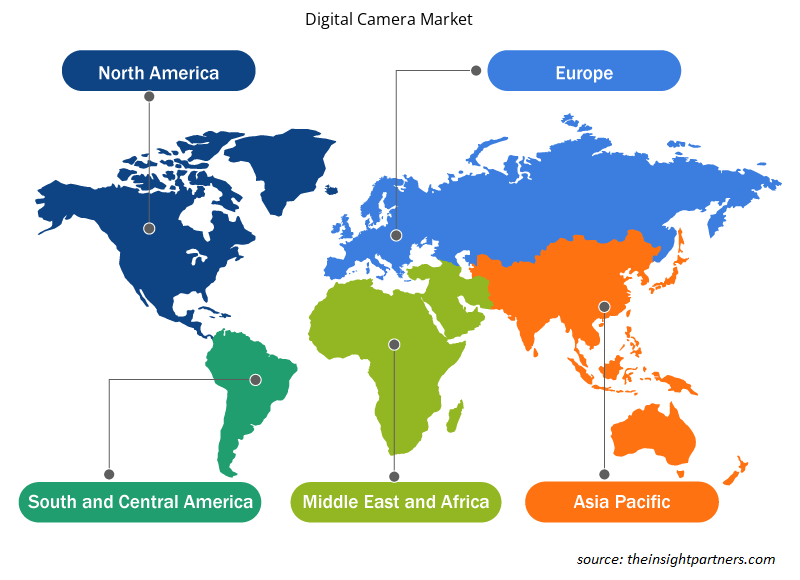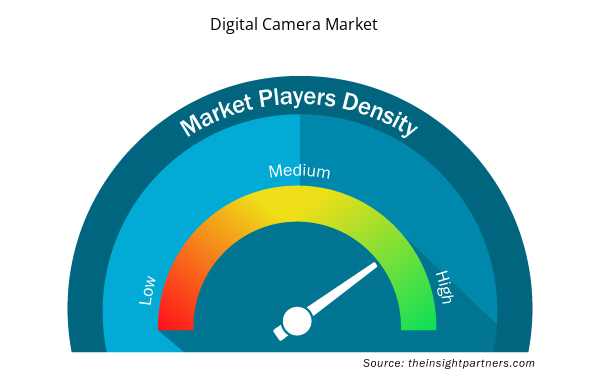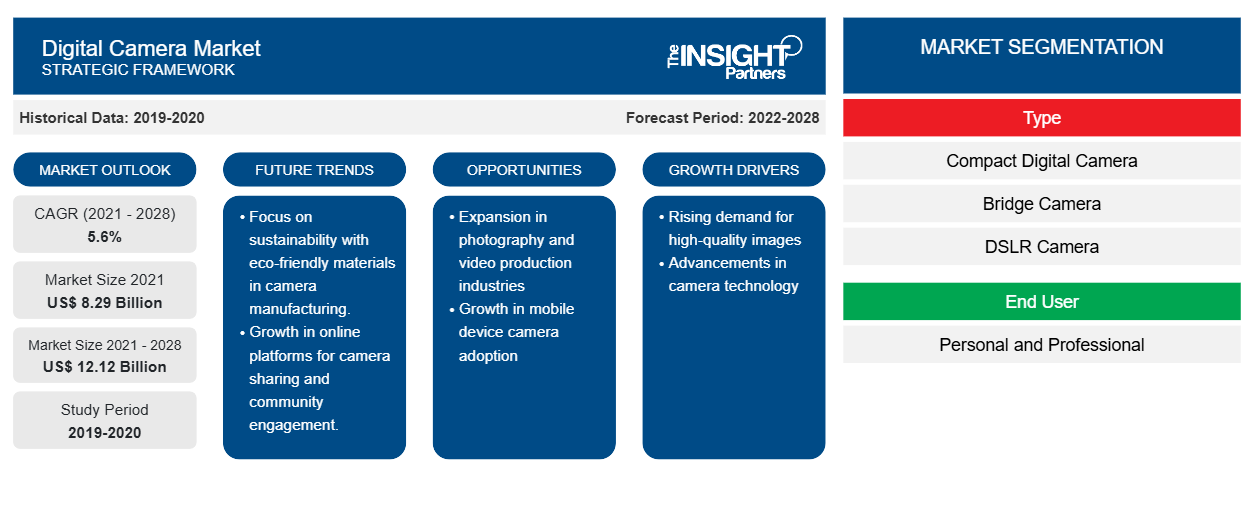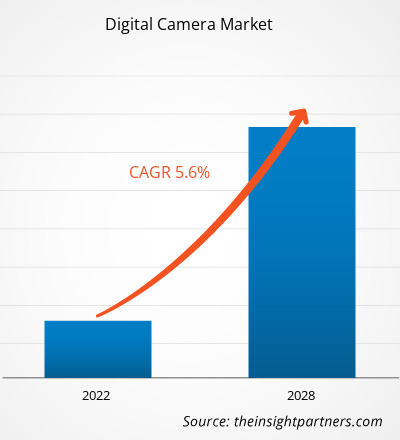من المتوقع أن ينمو سوق الكاميرات الرقمية من 8،290.25 مليون دولار أمريكي في عام 2021 إلى 12،119.44 مليون دولار أمريكي بحلول عام 2028؛ ومن المتوقع أن ينمو بمعدل نمو سنوي مركب قدره 5.6٪ خلال الفترة 2021-2028.
لم يقتصر استخدام الكاميرات الرقمية على التصوير الشخصي والمهني فحسب، بل امتد إلى صناعات الترفيه والإعلام والرياضة. تعد صناعة الأفلام واحدة من أكبر الفئات وأكثرها ربحية في صناعة الترفيه العالمية. على سبيل المثال، تعد صناعة الأفلام في الصين واحدة من أكبر صناعات الأفلام في العالم، حيث حققت إيرادات بلغت حوالي 6.6 مليار دولار أمريكي في عام 2016. ومن المتوقع أن تعمل هذه النظرة الواعدة لصناعة الأفلام والترفيه على دفع الطلب على الكاميرات الرقمية لتحقيق لقطات ومقاطع فيديو مثالية. لقد غيرت التغييرات التكنولوجية السريعة وسلوك المستهلك ونماذج الأعمال الطريقة التي يريد بها المستهلكون تجربة ودفع ثمن الترفيه والإعلام. يركز القادة في هذه الصناعة على بناء أعمال وعلامات تجارية تركز على المعجبين لإنتاج محتوى متميز. ونتيجة لذلك، يستثمرون مبلغًا كبيرًا في التقنيات والمعدات مثل الصور المولدة بواسطة الكمبيوتر (CGI) والمؤثرات البصرية (VFX)، بالإضافة إلى الكاميرات المتقدمة.
أيضًا، هناك استخدام لا غنى عنه للكاميرات الرقمية في وسائل الإعلام الرياضية. إن تركيب كاميرات رقمية عالية السرعة في الاستاد يتيح للمتفرجين مشاهدة إعادة عرض الحركة البطيئة في مواقف حرجة من اللعبة ويساعد في الحصول على الدقة أثناء المشاهدة. وعلى نحو مماثل، يساعد استخدام الكاميرات الرقمية عالية الدقة في تصوير الحياة البرية والمناظر الطبيعية والهندسة المعمارية والاستوديو في الحصول على صور ومقاطع فيديو حادة ونقية. وقد أدى التركيز المتزايد على التصوير الفوتوغرافي للأحداث إلى تعزيز الطلب على الكاميرات الرقمية المدمجة، مثل GoPro. وعلاوة على ذلك، عملت منصات التواصل الاجتماعي، مثل Instagram، على توسيع نطاق التصوير الفوتوغرافي بشكل كبير، وهو ما من المتوقع بدوره أن يؤدي إلى انتشار نمو سوق الكاميرات الرقمية.
قم بتخصيص هذا التقرير ليناسب متطلباتك
ستحصل على تخصيص لأي تقرير - مجانًا - بما في ذلك أجزاء من هذا التقرير، أو تحليل على مستوى الدولة، وحزمة بيانات Excel، بالإضافة إلى الاستفادة من العروض والخصومات الرائعة للشركات الناشئة والجامعات
- احصل على أهم اتجاهات السوق الرئيسية لهذا التقرير.ستتضمن هذه العينة المجانية تحليلاً للبيانات، بدءًا من اتجاهات السوق وحتى التقديرات والتوقعات.
تأثير جائحة COVID-19 على سوق الكاميرات الرقمية في أوروبا:
لقد أثر جائحة فيروس كورونا على الاقتصادات والصناعات في مختلف البلدان بسبب عمليات الإغلاق وحظر السفر وإغلاق الشركات. تعد صناعة الإلكترونيات الاستهلاكية واحدة من الصناعات الرئيسية التي تعاني من اضطرابات خطيرة مثل انقطاع سلسلة التوريد وإغلاق مصانع الإنتاج وما إلى ذلك بسبب هذا الوباء. أثر إغلاق العديد من مصانع التصنيع والمصانع في المناطق الرائدة مثل أمريكا الشمالية وأوروبا وآسيا والمحيط الهادئ وأمريكا الجنوبية والشرق الأوسط وأفريقيا على سلسلة التوريد العالمية وأثر سلبًا على التصنيع وجداول التسليم ومبيعات السلع المختلفة. علاوة على ذلك، أعلنت العديد من الشركات بالفعل عن تأخيرات محتملة في تسليم المنتجات وانخفاض في مبيعات منتجاتها المستقبلية. بالإضافة إلى ذلك، فإن حظر السفر العالمي الذي فرضته دول في أوروبا وآسيا وأمريكا الشمالية يؤثر على فرص التعاون والشراكات التجارية. ومن المتوقع أن تؤثر كل هذه العوامل على صناعة الإلكترونيات الاستهلاكية بشكل سلبي وبالتالي تعمل كعامل مقيد لنمو الأسواق المختلفة المتعلقة بهذه الصناعة في الأشهر المقبلة. يتأثر سوق الكاميرات الرقمية بالوباء بسبب نقص الإنتاج إلى جانب مرافق النقل المحدودة.
رؤى سوق الكاميرات الرقمية
الابتكارات التكنولوجية المرتبطة بالكاميرات الرقمية ستعزز نمو سوق الكاميرات الرقمية
يرتبط إطار سوق الكاميرات الرقمية ارتباطًا وثيقًا بالاتجاهات الجذرية الناشئة المدعومة بالتطورات التكنولوجية المبتكرة والتقدم القوي، مثل HD وشاشة اللمس. منذ فترة طويلة، لاحظ السوق طلبًا أعلى على سوق الكاميرات الرقمية أحادية العدسة العاكسة وكاميرات SLR بسبب ميل المستهلك المتزايد نحو التصوير الفوتوغرافي المتقدم. ومع ذلك، أدى تقدم التكنولوجيا إلى إنشاء كاميرات عالية الدقة، والتي توفر 12-20 ميجا بكسل. أدى التطور المستمر في مجال الكاميرات الرقمية إلى تصميم كاميرات متقدمة بدقة أفضل وتركيز أسرع ودعم الأجهزة الطرفية المختلفة. كما لوحظ أيضًا زيادة في الاتجاه لدمج مودم Wi-Fi أو 4G في الكاميرات الرقمية لتوفير ميزة تنافسية على الهواتف الذكية. علاوة على ذلك، من المتوقع أن تكون هذه الكاميرات جزءًا من العديد من الأجهزة المترابطة، مثل إنترنت الأشياء (IoT)، والتي يمكن أن تسهل الاتصال الفعال مع الأجهزة المترابطة الأخرى مثل الهواتف الذكية ومساعدي السماعات في المستقبل القريب.
رؤى السوق القائمة على النوع
وفقًا للنوع، يتم تصنيف سوق الكاميرات الرقمية إلى كاميرا رقمية مدمجة، وكاميرا جسرية، وكاميرا DSLR، وكاميرا بدون مرآة، وكاميرا رقمية لتحديد المدى، وكاميرا مسح خطي. في عام 2020، استحوذت شريحة كاميرات DSLR على أكبر حصة في السوق.
رؤى إقليمية حول سوق الكاميرات الرقمية
لقد قام المحللون في Insight Partners بشرح الاتجاهات والعوامل الإقليمية المؤثرة على سوق الكاميرات الرقمية طوال فترة التوقعات بشكل شامل. يناقش هذا القسم أيضًا قطاعات سوق الكاميرات الرقمية والجغرافيا في جميع أنحاء أمريكا الشمالية وأوروبا ومنطقة آسيا والمحيط الهادئ والشرق الأوسط وأفريقيا وأمريكا الجنوبية والوسطى.

- احصل على البيانات الإقليمية المحددة لسوق الكاميرات الرقمية
نطاق تقرير سوق الكاميرات الرقمية
| سمة التقرير | تفاصيل |
|---|---|
| حجم السوق في عام 2021 | 8.29 مليار دولار أمريكي |
| حجم السوق بحلول عام 2028 | 12.12 مليار دولار أمريكي |
| معدل النمو السنوي المركب العالمي (2021 - 2028) | 5.6% |
| البيانات التاريخية | 2019-2020 |
| فترة التنبؤ | 2022-2028 |
| القطاعات المغطاة | حسب النوع
|
| المناطق والدول المغطاة | أمريكا الشمالية
|
| قادة السوق وملفات تعريف الشركات الرئيسية |
|
كثافة اللاعبين في السوق: فهم تأثيرها على ديناميكيات الأعمال
يشهد سوق الكاميرات الرقمية نموًا سريعًا، مدفوعًا بالطلب المتزايد من المستخدم النهائي بسبب عوامل مثل تفضيلات المستهلك المتطورة والتقدم التكنولوجي والوعي المتزايد بفوائد المنتج. ومع ارتفاع الطلب، تعمل الشركات على توسيع عروضها والابتكار لتلبية احتياجات المستهلكين والاستفادة من الاتجاهات الناشئة، مما يؤدي إلى زيادة نمو السوق.
تشير كثافة اللاعبين في السوق إلى توزيع الشركات أو المؤسسات العاملة في سوق أو صناعة معينة. وهي تشير إلى عدد المنافسين (اللاعبين في السوق) الموجودين في مساحة سوق معينة نسبة إلى حجمها أو قيمتها السوقية الإجمالية.
الشركات الرئيسية العاملة في سوق الكاميرات الرقمية هي:
- شركة كانون
- شركة إيستمان كوداك (جيه كيه إميجنج المحدودة)
- شركة فوجي فيلم القابضة
- كاميرا لايكا ايه جي
- شركة نيكون
إخلاء المسؤولية : الشركات المذكورة أعلاه ليست مرتبة بأي ترتيب معين.

- احصل على نظرة عامة على أهم اللاعبين الرئيسيين في سوق الكاميرات الرقمية
رؤى السوق المستندة إلى المستخدم النهائي
بناءً على التطبيق، يتم تقسيم سوق الكاميرات الرقمية إلى شخصي ومهني. في عام 2020، استحوذت الشريحة المهنية على حصة سوقية أكبر.
يتبنى اللاعبون العاملون في السوق الرقمية استراتيجيات مثل عمليات الدمج والاستحواذ والمبادرات السوقية للحفاظ على مواقعهم في السوق. وفيما يلي قائمة ببعض التطورات التي قام بها اللاعبون الرئيسيون:
- أعلنت شركة FUJIFILM Holdings Corporation عن إطلاق كاميرا FUJIFILM GFX100S في أواخر فبراير 2021. وتُعد الكاميرا أحدث إضافة إلى سلسلة GFX من الكاميرات الرقمية بدون مرآة.
- أطلقت شركة Nikon Corporation الكاميرا Z 7II ذات الإطار الكامل بدون مرآة. تعد Z 7II كاميرا ذات إطار كامل عالية الدقة بدون مرآة. ومن خلال إطلاق مثل هذه المنتجات، تساهم الشركة في تطوير ثقافة التصوير.
تم تقسيم سوق الكاميرات الرقمية على النحو التالي:
حسب النوع
- كاميرا رقمية صغيرة الحجم
- كاميرا الجسر
- كاميرا DSLR
- كاميرا بدون مرآة
- كاميرا تحديد المدى الرقمية
- كاميرا المسح الخطي
حسب المستخدم النهائي
- شخصي
- احترافي
حسب الجغرافيا
أمريكا الشمالية
- نحن
- كندا
- المكسيك
أوروبا
- فرنسا
- ألمانيا
- إيطاليا
- المملكة المتحدة
- روسيا
- بقية أوروبا
آسيا والمحيط الهادئ (APAC)
- الصين
- الهند
- كوريا الجنوبية
- اليابان
- أستراليا
- بقية منطقة آسيا والمحيط الهادئ
الشرق الأوسط وأفريقيا
- جنوب أفريقيا
- المملكة العربية السعودية
- الامارات العربية المتحدة
- باقي منطقة الشرق الأوسط وأفريقيا
أمريكا الجنوبية (SAM)
- البرازيل
- الأرجنتين
- بقية سام
ملفات تعريف الشركة
- شركة كانون
- شركة ايستمان كوداك
- شركة فوجي فيلم القابضة
- كاميرا لايكا ايه جي
- شركة نيكون
- شركة أوم للحلول الرقمية
- شركة باناسونيك
- هاسيلبلاد
- شركة ريكو للتصوير المحدودة
- شركة سوني
- التحليل التاريخي (سنتان)، السنة الأساسية، التوقعات (7 سنوات) مع معدل النمو السنوي المركب
- تحليل PEST و SWOT
- حجم السوق والقيمة / الحجم - عالميًا وإقليميًا وقطريًا
- الصناعة والمنافسة
- مجموعة بيانات Excel



Report Coverage
Revenue forecast, Company Analysis, Industry landscape, Growth factors, and Trends

Segment Covered
This text is related
to segments covered.

Regional Scope
North America, Europe, Asia Pacific, Middle East & Africa, South & Central America

Country Scope
This text is related
to country scope.
الأسئلة الشائعة
DSLR cameras held the largest share in 2020 and they are the most versatile, high-end, and advanced type cameras. These cameras use single-lens reflex method. They consist of a mirror, which reflects the light passing through the lens. DSLR cameras are mostly large in size. These cameras are mainly used by professional photographers or videographers for commercial purposes. Automatic mode and changeable camera lens to fit different situations are the important feature of DSLR cameras. However, DSLR camera manufacturers are now focusing on integrating software enhancements and other technologies in these cameras for enhanced consumer experience, this factor is expected to drive the demand in the coming years.
With the growing trend toward photography, the demand for digital cameras is expanding. Digital camera allows to capture and store photos and videos digitally rather than printing it to film as per traditional analog cameras. As the consumers are becoming enthusiastic toward sight capturing, the demand for compact, lightweight, and high-quality cameras is rising. Further, the introduction of digital cameras and smartphones has created photography a mainstream profession, which have subsequently generated the need for high quality cameras with user-friendly interface and affordable price.
Mirrorless cameras are expected to drive the future growth of digital camera market. A mirrorless system camera does not involve a mirror box within its body and are designed with a compact and attractive exterior with an electronic viewfinder paired with interchangeable lens. Such cameras offer convenience in use compared to digital SLR cameras owing to their smaller and lighter structure. Mirrorless camera comprises lens at the front body along with sensor placed inside and a screen along with an optional viewfinder placed at the back. Additionally, such cameras have small, short, and light lenses and are constructed with a tiny LED or OLED screen, which helps to deliver best possible results altogether. Hence, the expanding demand for mirrorless cameras is expected to create lucrative opportunities for the growth of the digital cameras market.
The List of Companies - Digital Camera Market
- Canon Inc.
- Eastman Kodak Company (JK Imaging Ltd.)
- Fujifilm Holdings Corporation
- Leica Camera Ag
- Nikon Corporation
- Om Digital Solutions Corporation
- Panasonic Corporation
- Hasselblad
- Ricoh Imaging Company, Ltd
- Sony Corporation
The Insight Partners performs research in 4 major stages: Data Collection & Secondary Research, Primary Research, Data Analysis and Data Triangulation & Final Review.
- Data Collection and Secondary Research:
As a market research and consulting firm operating from a decade, we have published and advised several client across the globe. First step for any study will start with an assessment of currently available data and insights from existing reports. Further, historical and current market information is collected from Investor Presentations, Annual Reports, SEC Filings, etc., and other information related to company’s performance and market positioning are gathered from Paid Databases (Factiva, Hoovers, and Reuters) and various other publications available in public domain.
Several associations trade associates, technical forums, institutes, societies and organization are accessed to gain technical as well as market related insights through their publications such as research papers, blogs and press releases related to the studies are referred to get cues about the market. Further, white papers, journals, magazines, and other news articles published in last 3 years are scrutinized and analyzed to understand the current market trends.
- Primary Research:
The primarily interview analysis comprise of data obtained from industry participants interview and answers to survey questions gathered by in-house primary team.
For primary research, interviews are conducted with industry experts/CEOs/Marketing Managers/VPs/Subject Matter Experts from both demand and supply side to get a 360-degree view of the market. The primary team conducts several interviews based on the complexity of the markets to understand the various market trends and dynamics which makes research more credible and precise.
A typical research interview fulfils the following functions:
- Provides first-hand information on the market size, market trends, growth trends, competitive landscape, and outlook
- Validates and strengthens in-house secondary research findings
- Develops the analysis team’s expertise and market understanding
Primary research involves email interactions and telephone interviews for each market, category, segment, and sub-segment across geographies. The participants who typically take part in such a process include, but are not limited to:
- Industry participants: VPs, business development managers, market intelligence managers and national sales managers
- Outside experts: Valuation experts, research analysts and key opinion leaders specializing in the electronics and semiconductor industry.
Below is the breakup of our primary respondents by company, designation, and region:

Once we receive the confirmation from primary research sources or primary respondents, we finalize the base year market estimation and forecast the data as per the macroeconomic and microeconomic factors assessed during data collection.
- Data Analysis:
Once data is validated through both secondary as well as primary respondents, we finalize the market estimations by hypothesis formulation and factor analysis at regional and country level.
- Macro-Economic Factor Analysis:
We analyse macroeconomic indicators such the gross domestic product (GDP), increase in the demand for goods and services across industries, technological advancement, regional economic growth, governmental policies, the influence of COVID-19, PEST analysis, and other aspects. This analysis aids in setting benchmarks for various nations/regions and approximating market splits. Additionally, the general trend of the aforementioned components aid in determining the market's development possibilities.
- Country Level Data:
Various factors that are especially aligned to the country are taken into account to determine the market size for a certain area and country, including the presence of vendors, such as headquarters and offices, the country's GDP, demand patterns, and industry growth. To comprehend the market dynamics for the nation, a number of growth variables, inhibitors, application areas, and current market trends are researched. The aforementioned elements aid in determining the country's overall market's growth potential.
- Company Profile:
The “Table of Contents” is formulated by listing and analyzing more than 25 - 30 companies operating in the market ecosystem across geographies. However, we profile only 10 companies as a standard practice in our syndicate reports. These 10 companies comprise leading, emerging, and regional players. Nonetheless, our analysis is not restricted to the 10 listed companies, we also analyze other companies present in the market to develop a holistic view and understand the prevailing trends. The “Company Profiles” section in the report covers key facts, business description, products & services, financial information, SWOT analysis, and key developments. The financial information presented is extracted from the annual reports and official documents of the publicly listed companies. Upon collecting the information for the sections of respective companies, we verify them via various primary sources and then compile the data in respective company profiles. The company level information helps us in deriving the base number as well as in forecasting the market size.
- Developing Base Number:
Aggregation of sales statistics (2020-2022) and macro-economic factor, and other secondary and primary research insights are utilized to arrive at base number and related market shares for 2022. The data gaps are identified in this step and relevant market data is analyzed, collected from paid primary interviews or databases. On finalizing the base year market size, forecasts are developed on the basis of macro-economic, industry and market growth factors and company level analysis.
- Data Triangulation and Final Review:
The market findings and base year market size calculations are validated from supply as well as demand side. Demand side validations are based on macro-economic factor analysis and benchmarks for respective regions and countries. In case of supply side validations, revenues of major companies are estimated (in case not available) based on industry benchmark, approximate number of employees, product portfolio, and primary interviews revenues are gathered. Further revenue from target product/service segment is assessed to avoid overshooting of market statistics. In case of heavy deviations between supply and demand side values, all thes steps are repeated to achieve synchronization.
We follow an iterative model, wherein we share our research findings with Subject Matter Experts (SME’s) and Key Opinion Leaders (KOLs) until consensus view of the market is not formulated – this model negates any drastic deviation in the opinions of experts. Only validated and universally acceptable research findings are quoted in our reports.
We have important check points that we use to validate our research findings – which we call – data triangulation, where we validate the information, we generate from secondary sources with primary interviews and then we re-validate with our internal data bases and Subject matter experts. This comprehensive model enables us to deliver high quality, reliable data in shortest possible time.


 احصل على عينة مجانية لهذا التقرير
احصل على عينة مجانية لهذا التقرير